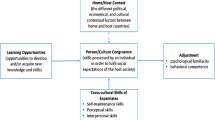Abstract
This study is a secondary analysis based on the study of Peng (Culture and conflict management in foreign-invested enterprises in China: an intercultural communication perspective. Peter Lang, Bern, 2003). The distribution of five categories of work-related conflicts was tabulated and analyzed among American, French, and Chinese employees in foreign-invested enterprises (FIEs) as well as Chinese employees in state-owned enterprises (SOEs) in mainland China. These are conflicts on salary, promotion, and fringe benefits, conflict on job assignment, conflict on worldview, conflict on personal taste and character, and conflict on management styles. The results of the data analysis generated an emerging pattern of conflict distribution that basically corresponds to the conflict management patterns of Western and Chinese employees in foreign-invested enterprises. The results of this study indicate that for conflict on salary, the Chinese have a higher conflict potential than Americans and French, whereas Americans have a higher conflict potential on management styles than French and Chinese. The influence of cultural values on conflict management styles is clearly reflected by the differences among American, Chinese, and French across their respective management styles over all five categories of conflicts. Between the FIE Chinese and SOE Chinese, significant differences are also found over the management styles of the five conflicts. The overall results of this study provide us with an insightful understanding that the collectivistic and individualistic orientations of high-contextual and low-contextual cultural members are not always aligned with the nonconfrontational and confrontational conflict management styles as we customarily believe. Conflict management styles should be expected, explained, and interpreted through a combination of cultural orientation, conflict stake, and personality.
Access this chapter
Tax calculation will be finalised at checkout
Purchases are for personal use only
Similar content being viewed by others
References
Cai, B., and A. Gonzalez. 1997–1998. The Three Gorges project: Technological discourse and the resolution of competing interests [Special issue]. Intercultural Communication Studies 7(1): 101–111.
Chen, Y.R., and X.M. Hao. 1997–1998. Conflict resolution in love triangles: Perspectives offered by Chinese TV dramas [Special issue]. Intercultural Communication Studies 7(1): 133–148.
Fischer, M. 2013. Language choice as a potential source of intercultural discord in English-Mandarin business encounters. China Media Research 9(4): 45–52.
Friedman, R.A., S.T. Tidd, S.C. Currall, and J.C. Tsai. 2000. What goes around comes around: The impact of personal conflict style on work conflict and stress. International Journal of Conflict Management 11(1): 32–55.
Fuller, E., and R.B. Peterson. 1992. China and Taiwan: Common culture but divergent economic success. In Advances in International Comparative Management, 7, ed. B.B. Prasaol, 185–201. Greenwich: JAI Press.
Gross, M.A., and L.K. Guerrero. 2000. Managing conflict appropriately and effectively: An application of the competence model to Rahim’s organizational conflict styles. International Journal of Conflict Management 11(3): 200–226.
Hofstede, G. 1980. Culture’s consequences. Beverly Hills: Sage.
Hofstede, G. 1991. Cultures and organizations: Software of the mind. London: McGraw-Hill.
Hwang, K.K. 1987. Face and favor: The Chinese power game. American Journal of Sociology 92(4): 944–974.
Hwang, K.K. 1997–1998. Guanxi and Mientze: Conflict resolution in Chinese society [Special issue]. Intercultural Communication Studies 7(1): 17–42.
Jehn, K., and E. Weldon. 1997. Managerial attitudes toward conflict: Cross-cultural differences in resolution styles. Journal of International Management 3(4): 291–321.
Jia, W.S. 1997–1998. Facework as a Chinese conflict-preventative mechanism: A cultural discourse analysis [Special issue]. Intercultural Communication Studies 7(1): 43–61.
Kozan, M.K. 1989. Cultural influences on styles of handling interpersonal conflicts: Comparisons among Jordanian, Turkish, and U.S. managers. Human Relations 42(9): 787–799.
Leung, K. 1988. Some determinants of conflict avoidance. Journal of Cross-Cultural Psychology 19(1): 125–136.
Leung, K., and E.A. Lind. 1986. Procedural Justice and culture: Effects of culture, gender, and investigator status on procedural preferences. Journal of Personality and Social Psychology 50(6): 1134–1140.
Ma, Z., A. Erkus, and A. Tabak. 2010. Explore the impact of collectivism on conflict management styles: A Turkish study. International Journal of Conflict Management, 21(2): 169–185.
Peng, S.Y., Z. He, and J.H. Zhu. 2000. Conflict management styles among employees of Sino-American, Sino-French, and state-owned enterprises in China [Special issue]. Intercultural Communication Studies 9(2): 33–46.
Peng, S.Y. 2003. Culture and conflict management in foreign-invested enterprises in China: An intercultural communication perspective. Bern: Peter Lang.
Rahim, M.A. (ed.). 1989. Managing conflict: An interdisciplinary approach. New York: Praeger.
Ting-Toomey, S. 1985. Toward a theory of conflict and culture. In Communication culture, and organizational processes, ed. W.B. Gudykunst, L.P. Stewart, and S. Ting-Toomey, 71–86. Beverly Hills: Sage.
Triandis, H.C., R. Brislin, and C.H. Hui. 1988. Cross-cultural training across the individualism-collectivism. International Journal of Intercultural Relations 12(3): 269–289.
Trubisky, P., S. Ting-Toomey, and S.L. Lin. 1991. The influence of individualism collectivism and self-monitoring on conflict styles. International Journal of Intercultural Relations 15(1): 65–84.
Tse, D.K., J. Francis, and J. Walls. 1994. Cultural differences in conducting intra- and inter-Cultural negotiations: A Sino-Canadian comparison. Journal of International Business Studies 25(3): 537–555.
Wang, J.L., and W. Wu. 1997–1998. Ideological work as conflict management: A dialectical approach in Chinese communication campaigns [Special issue]. Intercultural Communication Studies 7(1): 83–99.
Yu, X.J. 1997–1998. The Chinese native perspective on mao-dun (conflict) and mao-dun resolution strategies: A qualitative investigation [Special issue]. Intercultural Communication Studies 7(1): 63–82.
Author information
Authors and Affiliations
Corresponding author
Editor information
Editors and Affiliations
Rights and permissions
Copyright information
© 2015 Springer-Verlag Berlin Heidelberg
About this chapter
Cite this chapter
Peng, S. (2015). Distributions of Conflict Potentials Among Western and Chinese Employees in Multinational Corporations in China. In: Ng, P., Ngai, C. (eds) Role of Language and Corporate Communication in Greater China. Springer, Berlin, Heidelberg. https://doi.org/10.1007/978-3-662-46881-4_10
Download citation
DOI: https://doi.org/10.1007/978-3-662-46881-4_10
Publisher Name: Springer, Berlin, Heidelberg
Print ISBN: 978-3-662-46880-7
Online ISBN: 978-3-662-46881-4
eBook Packages: Humanities, Social Sciences and LawSocial Sciences (R0)




